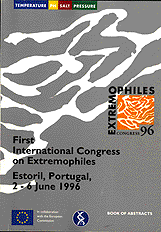Unique Patterns of DNA Topology and DNA Topoisomerases in
Hyperthermophilic Archaea
Patrick Forterre, A. Bergerat, P. Lopez-Garcia, D. Gadelle, Y. Zivanovic and E. Marguet
Université Paris-Sud, Bat 409, 91405, Orsay Cedex, France.
All Hyperthermophilic (HT), and some thermophilic Bacteria and Archaea possess a unique enzyme, reverse gyrase (RG), which positively supercoils DNA [i.e. increase the Linking number, (Lk)] (1, 2). RG is a combination of helicase-like module and a topoisomerase I module. Beside RG, the hyperthermophilic archaea Sulfolobus and Pyrococcus contain a DNA topoisomerase II without gyrase activity (2, 3).
We speculated that this unique pattern of DNA topoisomerase activities should end up with a unusual DNA topological state. We had previously shown that DNA of the virus SSVl from
Sulfolobus shibatae was positively supercoiled (4), whilst plasmids pGT5 from Pyrococcus
abyssi and pSL10 from Desulfurolobus ambivalens were relaxed, instead to be negatively
supercoiled as in Bacteria, Eucarya and mesophilic archaea (5, 6). We have now generalized
these findings by studying several new plasmids from Thermococcales and Sulfolobales
(collaboration with D. Prieur and W. Zillig). All of them are from relaxed to highly positively
supercoiled. In addition, we have observed dramatic topological changes during heat-shock or
cold shock. These results suggest that a Lk excess, probably introduced by RG, is essential to
maintain the DNA in a functional state in HT, and that these organisms use topological
changes to modulate their answers to temperature stresses.
RG was the first gift of HT Archaea to DNA topologists. It turns out now that their Topo II is the second one. We have cloned and sequenced the two subunits, A and B, of the Topo II
from S. shibatae. Surprisingly, only the N-terminus of subunit B exhibits similarities with
other Topo II. Since all bacterial and eucaryal Topo II previously analyzed were similar, the
HT Topo II defined a completely new family. Furthermore, in silico analysis suggests that this
new Topo II (Topo VI) could be also present in eucaryotes beside the classical one.
1. Duguet 1995. In Nucleic acids and Molecular Biology, Vol. 9, D. Lilley and F. Eckstein, eds, (Springer
Verlag.) 84-114.
2. Forterre, P., Bergerat, A., Lopez-Garcia, P. FEMS Microbiol. Rev. (in press).
3. Bergerat, A., Gadelle D., Forterre, P. 1994. J Biol. Chem. 269:27663-27669.
4. Nadal, M., Mirambeau, G., Forterre, P., Reiter, W. D., Duguet, M. 1986. Nature 321:256-258.
5. Charbonnier, F., Erauso, G., Barbeyron, T., Prieur, D., Forterre, P. 1992. J. Bacteriol. 174:6103-6108.
6. Charbonnier, F., Forterre, P. 1994. J Bacteriol. 176:1251-1259.
|
















